
views
- Number of Players: 2-10
- Setup: Choose 1 player to be “it,” and have them think of a secret person, place or thing.
- Object of the game: Other players attempt to guess the secret person, place, or thing, but they only get 20 questions to do so.
Gameplay & Rules

Gather a group of 2 to 10 people and choose someone to be “it." This game works best with a small to medium-sized group of people, so that everyone gets a chance to ask a question. Choose a random player to be “it.” This could be the youngest player in the group, the player who’s had the most recent birthday, or something silly, like who can eat a piece of pizza the fastest. If the group is too big, like more than 15 people, you may reach the end of the game without giving everyone a turn. This is a great game to play on a road trip or with a group of friends to pass the time.

Think of a person, place, or thing for other players to guess if you’re “it.” Think of someone or something that you know enough about to answer some basic questions about, and keep it a secret! If you choose a person, they can be living, deceased, or even fictional. Make sure you choose a person, place, or thing that most people in your group know about. For example, your item could be “Marylin Monroe,” since she is famous enough that most people will be able to make guesses about her. You could also choose something like New York City, the Eiffel Tower, or even clouds or the sun. Avoid items like “my mom” or “my dog” unless you are with your siblings or best friends, since the players might not know enough about them to guess.

Ask yes-or-no questions if you're not "it." If you’re not “it,” your goal is to figure out what the “it” person is thinking of by asking questions to narrow down the possibilities. Try using a fairly general opening question that can be answered with “yes” or “no” to narrow down your options. For example: “Is it alive?” “Is it an object?” “Is it fictional?” “Is it bigger than a toaster?

Take turns asking more specific yes-or-no questions to narrow it down. You can ask questions in any order that you’d like, but make sure each player gets to ask at least 1 question. If a player asks a question that can’t be answered with “yes” or “no,” ask them to rephrase it so that it can be, since the person who’s “it” can only say “yes” or “no.” For example, a player couldn’t ask, “How old are they?” or “What do they look like?” They could ask, “Are they older than 50?” or, “Do they have blonde hair?” Think about the questions that have already been asked before you ask new questions. For example, you could go from "Is it a person?" to "Is it a man?" to "Are they alive?" to "Do they live in America?"

Play until you reach 20 questions or someone guesses the right answer. Either assign someone to count the questions that each player asks, or count them together as a group. If you think you know what the answer is, use 1 of the group’s 20 questions to guess! But if the group reaches 20 questions and they haven’t guessed the person, place, or thing, the person who’s “it” reveals what it is. For example, you might ask, “Is the answer Marilyn Monroe?” If you’re right, the group wins! If you’re wrong, it counts as 1 of your 20 questions.

Become the next “it” person if you guess the correct answer. The person who guesses the right answer is next to be “it,” and they think up their own secret person, place, or thing. If no one guessed the person, place, or thing at all, whoever wants to go next can have a turn. Keep the game going until everyone has had a chance to be “it.” If someone guesses correctly but they’ve already been “it,” let someone else have a turn instead. Giving everyone a turn makes the game more inclusive and lets everybody have some fun!
Ideas for Questions
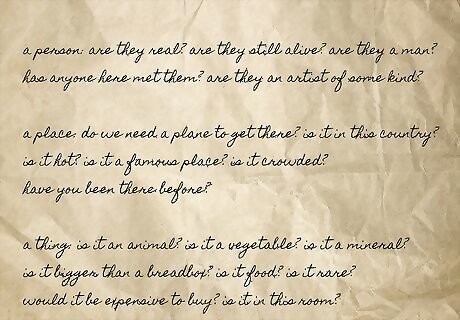
Use some classic questions to find the answer more quickly. As you play, it’s best to make your questions gradually more specific to really zero in on the answer. The questions you ask will depend on what you’ve asked already and what you’ve already found out, but also ask some time-honored questions that veteran players often use to find the answer more efficiently. If it’s a person: Are they real? Are they still alive? Are they a man? Has anyone here met them? Are they an artist of some kind? If it’s a place: Do we need a plane to get there? Is it in this country? Is it hot? Is it a famous place? Is it crowded? Have you been there before? If it’s a thing: Is it an animal? Is it a vegetable? Is it a mineral? Is it bigger than a breadbox? Is it food? Is it rare? Would it be expensive to buy? Is it in this room?
Ideas for Answers
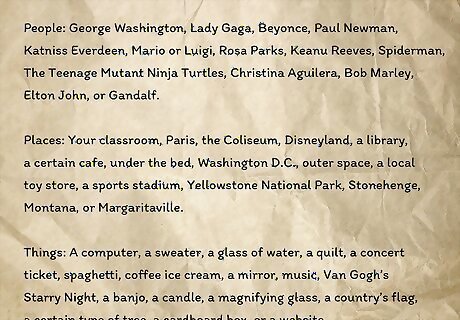
Choose an answer that anyone in the room could guess. When playing 20 Questions, it’s most fun to choose an answer that anyone you’re playing with could deduce. That usually means picking something that everyone’s at least somewhat familiar with. Here’s a handy list of possible answers, if you need a little inspiration: People: George Washington, Lady Gaga, Beyonce, Paul Newman, Katniss Everdeen, Mario or Luigi, Rosa Parks, Keanu Reeves, Spiderman, The Teenage Mutant Ninja Turtles, Christina Aguilera, Bob Marley, Elton John, or Gandalf. Places: Your classroom, Paris, the Coliseum, Disneyland, a library, a certain cafe, under the bed, Washington D.C., outer space, a local toy store, a sports stadium, Yellowstone National Park, Stonehenge, Montana, or Margaritaville. Things: A computer, a sweater, a glass of water, a quilt, a concert ticket, spaghetti, coffee ice cream, a mirror, music, Van Gogh’s Starry Night, a banjo, a candle, a magnifying glass, a country’s flag, a certain type of tree, a cardboard box, or a website.
Playing 20 Questions with ESL Learners

Write out 10 to 15 topic cards with different subjects of interest. For example, you could pick popular foods, American states, famous landmarks, types of animals, or even famous celebrities. Choose a random bunch of these topics and write them down individually on a note card.Tip: Pick topics that you have talked about in class before to make sure your students will know about them.
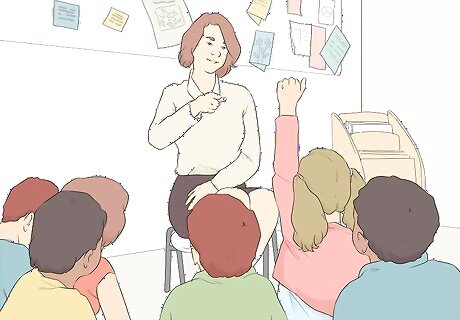
Choose 1 person to be “it” and have them read their topic out loud. Pick a volunteer from your class to be the first person to choose a topic. You could pick the student who has been on time to class the most, or choose someone who turned their homework in on time that day. Have them pull a topic card from the pile and let them read it out loud to the class. This narrows down the subject that the person, place, or thing could be to make it easier for your students to guess than in a traditional game of 20 Questions.
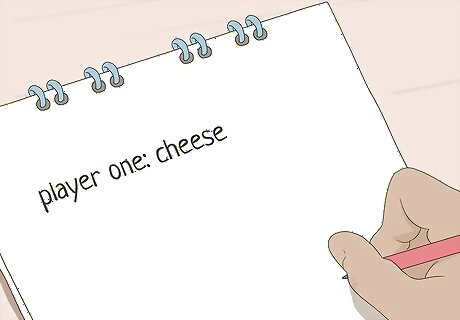
Write down the item or person that the “it” player thinks of. The player who’s “it” thinks of their secret person, place, or object within their category, then writes it down and hands it to you, the instructor. This ensures that you know what their item is in case the rest of your students get stuck. Double-check that the person, place, or thing and the subject card are related, or offer suggestions if your student can’t think of anything. For example, if your student pulls the card “types of animals,” they could choose “rabbit,” "koala," or "mountain lion," as their item.

Take turns asking grammatically correct yes-or-no questions. Let each student have an opportunity to ask a question, with the student who’s “it” answering “yes” or “no.” If a student’s question isn’t grammatically correct, use it as an opportunity to demonstrate correct grammar and vocabulary, offering alternative phrasing and explaining the question’s structure. Also, help the student who’s “it” to understand the question with alternate phrasing if they’re confused. Let students raise their hands when they have a question, or go around the room in a circle or spiral. If anyone gets stuck, try giving suggestions like, “Do you want to ask about its size?” Or, “Can you think of a way to ask about their hair color?”

Keep track of your students’ questions and award points for correct grammar. As you play the game, have your students keep track of how many questions they have asked that were grammatically correct. Award 1 point for each question, and 2 points for each grammatically correct question. Tally up the running total of questions asked so that you know when your students have reached 20. Assigning points makes the game more competitive and may motivate your students to play and to improve their grammar and vocabulary. Skip this step if you want a more relaxed, laid-back game with less pressure on your students.

Give 3 points to whoever guesses correctly and make them “it.” Have the student who guessed correctly pick a new subject and come up with their own item. If the group reaches 20 questions and no one has guessed the item, have the current “it” player say what it is and give them 1 extra point. Keep playing new rounds until everyone has gotten a turn, or stop when you feel like your students have gotten the most out of this game. If no one guesses correctly, ask for a volunteer to be “it” next, or choose a student who hasn’t had a chance to participate.
Similar Games

Botticelli, Vermicelli, and Vespucci These are all variants of 20 Questions, but with their categories narrowed down to a single subject. In Botticelli, the person who’s “it,” must think of a famous person. In Vermicelli, they must think of a food, and in Vespucci, they must think of physical places. Players then ask 20 questions to try to guess the answer.

Heads Up! Also called the “Forehead Game,” this game resembles 20 Questions, except that only 1 person guesses, while everyone else asks questions. To play Heads Up!, 1 person writes down a famous person on a notecard and hands it to the guesser. Without peeking, the guesser holds it up to their forehead, then asks yes-or-no questions until they guess the correct answer. Play with either a set number of guesses, like 20, or with a time limit of around 1 minute. Or, use the Heads Up! phone app, which automatically generates answers and keeps time.

I Spy To play I Spy, have 1 person choose a secret object in the room. Then, they provide a vague hint as to what it is. For example, they might say, “It’s soft” if their object is another player’s sweater. Then, each other player makes a single guess. If nobody guesses it, the “spy” offers another hint, and players each guess again, continuing until someone is correct.

Scattergories To play Scattergories, divide the players into equal teams and give each team a pad of paper and a pen. Then, choose a random letter of the alphabet plus 12 random, broad categories, such as countries, games, food, etc. Start a 3-minute timer. Each team must come up with an answer for each category that starts with the randomly chosen letter. Whoever has the most answers wins. For example, if the random letter is B and the first 3 categories are a dessert, a nickname, and a country, your team’s answers might be “banana split,” “Bernie,” and, “Belize.”















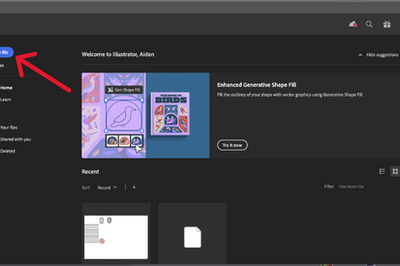




Comments
0 comment